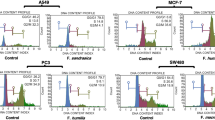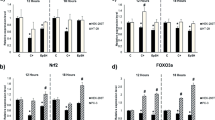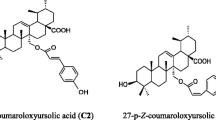Summary
The continual increase in mortality rates and number of cancer cases is a matter of serious concern in developing countries. The incorporation of natural products into classical cancer treatment approaches is a promising direction. The mechanisms of A549 and HeLa cancer cell death induction by ethanolic extracts of propolis samples from Phayao, Chiang Mai, and Nan provinces in northern Thailand were investigated in this study. The propolis extract from Chiang Mai showed the highest antioxidant activity and the greatest total phenolic content. The propolis extract from Nan also exhibited the highest total flavonoid content. The proliferation of A549 and HeLa cells grown in the presence of the propolis extracts was suppressed in a dose- and time-dependent manner. Moreover, treatment of both cancer cells with the propolis extracts showed DNA fragmentation and significantly increased the number of the apoptotic cells. On A549 cells, the extrinsic and intrinsic pathways of caspase enzymes were activated by the propolis extracts from Phayao and Chiang Mai. In the case of the propolis extract from Nan, the mechanisms involved apoptosis on the A549 cells were caspase-independent pathway. The extrinsic pathway of the caspase enzyme was triggered by all of the propolis extracts on HeLa cells. Finally, oral administration of the propolis granule produced from the propolis extract from Nan resulted in extended survival of tumour-bearing mice. Therefore, propolis extracts from the northern region of Thailand demonstrated pharmacological properties, both antioxidant and anticancer activities. From these findings, it is evident that propolis extracts can be considered as a naturally obtained agent extremely useful in cancer treatment.









Similar content being viewed by others
References
Sonnenschein C, Soto AM (2013) The aging of the 2000 and 2011 Hallmarks of Cancer reviews: a critique. J Biosci 38:651–663. doi:10.1038/nature12213
Elmore S (2007) Apoptosis: a review of programmed cell death. Toxicol Pathol 35:495–516. doi:10.1080/01926230701320337
Reed JC (2000) Mechanisms of apoptosis. Am J Pathol 157:1415–1430. doi:10.1016/S0002-9440(10)64779-7
McIlwain DR, Berger T, Mak TW (2013) Caspase functions in cell death and disease. Cold Spring Harb Perspect Biol 5:a008656. doi:10.1101/cshperspect.a008656
Tsujimoto Y (1998) Role of Bcl-2 family proteins in apoptosis: apoptosomes or mitochondria? Genes Cells 3:697–707. doi:10.1046/j.1365-2443.1998.00223.x
Wong RSY (2011) Apoptosis in cancer: from pathogenesis to treatment. J Exp Clin Cancer Res 30:1–14. doi:10.1186/1756-9966-30-87
Bankova VS, de Castro SL, Marcucci MC (2000) Propolis: recent advances in chemistry and plant origin. Apidologie 31:3–15. doi:10.1051/apido:2000102
Wagh VD (2013) Propolis: a wonder bees product and its pharmacological potentials. Adv Pharmacol Sci 2013:1–11. doi:10.1155/2013/308249
Khacha-ananda S, Tragoolpua K, Chantawannakul P, Tragoolpua Y (2013) Antioxidant and anti-cancer cell proliferation activity of propolis extracts from two extraction methods. Asian Pac J Cancer Prev 14:6991–6995. doi:10.7314/APJCP.2013.14.11.6991
Patel S (2016) Emerging adjuvant therapy for cancer: propolis and its constituents. J Diet Suppl 13:245–268. doi:10.3109/19390211.2015.1008614
Chen C-N, Wu C-L, Lin J-K (2007) Apoptosis of human melanoma cells induced by the novel compounds propolin A and propolin B from Taiwenese propolis. Cancer Lett 245:218–231. doi:10.1016/j.canlet.2006.01.016
Teerasripreecha D, Phuwapraisirisan P, Puthong S et al (2012) In vitro antiproliferative/cytotoxic activity on cancer cell lines of a cardanol and a cardol enriched from Thai Apis mellifera propolis. BMC Complement Altern Med 12:27. doi:10.1186/1472-6882-12-27
Trusheva B, Trunkova D, Bankova V (2007) Different extraction methods of biologically active components from propolis: a preliminary study. Chem Cent J 1:13. doi:10.1186/1752-153X-1-13
Ghasemi K, Ghasemi Y, Ebrahimzadeh MA (2009) Antioxidant activity, phenol and flavonoid contents of 13 citrus species peels and tissues. Pak J Pharm Sci 22:277–281
Mosmann T (1983) Rapid colorimetric assay for cellular growth and survival: application to proliferation and cytotoxicity assays. J Immunol Methods 65:55–63. doi:10.1016/0022-1759(83)90303-4
Zhu N, Wang Z (1997) An assay for DNA fragmentation in apoptosis without phenol/chloroform extraction and ethanol precipitation. Anal Biochem 246:155–158. doi:10.1006/abio.1997.2018
Prieto A, Díaz D, Barcenilla H et al (2002) Apoptotic rate: a new indicator for the quantification of the incidence of apoptosis in cell cultures. Cytometry 48:185–193. doi:10.1002/cyto.10132
He F, Wang Q, Zheng X-L et al (2012) Wogonin potentiates cisplatin-induced cancer cell apoptosis through accumulation of intracellular reactive oxygen species. Oncol Rep 28:601–605. doi:10.3892/or.2012.1841
Lan Y, Liu X, Zhang R et al (2013) Lithium enhances TRAIL-induced apoptosis in human lung carcinoma A549 cells. Biometals 26:241–254. doi:10.1007/s10534-012-9607-x
Tuve S, Liu Y, Tragoolpua K et al (2009) In situ adenovirus vaccination engages T effector cells against cancer. Vaccine 27:4225–4239. doi:10.1016/j.vaccine.2009.03.074
Sulaiman GM, Ad’hiah AH, Al-Sammarrae KW et al (2012) Assessing the anti-tumour properties of Iraqi propolis in vitro and in vivo. Food Chem Toxicol 50:1632–1641. doi:10.1016/j.fct.2012.01.022
Kujumgiev A, Tsvetkova I, Serkedjieva Y et al (1999) Antibacterial, antifungal and antiviral activity of propolis of different geographic origin. J Ethnopharmacol 64:235–240. doi:10.1016/S0378-8741(98)00131-7
Paviani L, Sacoda P, Saito E, Cabral F (2011) Extraction techniques of red and green propolis: extraction yield of phenolic compounds. Proc 11th Int Congr Eng Food, Greece, 22–26 May 2011
Biscaia D, Ferreira SRS (2009) Propolis extracts obtained by low pressure methods and supercritical fluid extraction. J Supercrit Fluids 51:17–23. doi:10.1016/j.supflu.2009.07.011
Park YK, Ikegaki M (2014) Preparation of water and ethanolic extracts of propolis and evaluation of the preparations. Biosci Biotechnol Biochem 62:2230–2232. doi:10.1271/bbb.62.2230
Chen L (2011) Extraction and antioxidant properties of propolis from China, Korea and Northern Thailand. Dissertation. Chulalongkorn University
Siripatrawan U, Vitchayakitti W, Sanguandeekul R (2013) Antioxidant and antimicrobial properties of Thai propolis extracted using ethanol aqueous solution. Int J Food Sci Technol 48:22–27. doi:10.1111/j.1365-2621.2012.03152.x
Athikomkulchai S, Awale S, Ruangrungsi N et al (2013) Chemical constituents of Thai propolis. Fitoterapia 88:96–100. doi:10.1016/j.fitote.2013.04.008
Sanpa S, Popova M, Tunkasiri T, et al (2016) Chemical profiles and antimicrobial activities of Thai propolis collected from Apis mellifera. Chiang Mai J Sci (Paper In Press)
Lirdprapamongkol K, Sakurai H, Abdelhamed S et al (2013) Chrysin overcomes TRAIL resistance of cancer cells through Mcl-1 downregulation by inhibiting STAT3 phosphorylation. Int J Oncol 43:329–337. doi:10.3892/ijo.2013.1926
Kimoto T, Aga M, Hino K et al (2011) Apoptosis of human leukemia cells induced by Artepillin C, an active ingredient of Brazilian propolis. Anticancer Res 21:221–228
Shen S-C, Ko CH, Tseng S-W et al (2004) Structurally related antitumor effects of flavanones in vitro and in vivo: involvement of caspase 3 activation, p21 gene expression, and reactive oxygen species production. Toxicol Appl Pharmacol 197:84–95. doi:10.1016/j.taap.2004.02.002
Seda Vatansever H, Sorkun K, Ismet Deliloğlu Gurhan S et al (2010) Propolis from Turkey induces apoptosis through activating caspases in human breast carcinoma cell lines. Acta Histochem 112:546–556. doi:10.1016/j.acthis.2009.06.001
Dreher D, Junod AF (1996) Role of oxygen free radicals in cancer development. Eur J Cancer 32A:30–38. doi:10.1016/0959-8049(95)00531-5
Khan HY, Zubair H, Ullah MF et al (2012) A prooxidant mechanism for the anticancer and chemopreventive properties of plant polyphenols. Curr Drug Targets 13:1738–1749. doi:10.2174/138945012804545560
Tsai Y-C, Wang Y-H, Liou C-C et al (2012) Induction of oxidative DNA damage by flavonoids of propolis: its mechanism and implication about antioxidant capacity. Chem Res Toxicol 25:191–196. doi:10.1021/tx200418k
Tsuchiya I, Hosoya T, Ushida M et al (2013) Nymphaeol-A isolated from Okinawan propolis suppresses angiogenesis and induces caspase-dependent apoptosis via inactivation of survival signals. Evidence-Based Complement Altern Med 2013:1–9. doi:10.1155/2013/826245
Li X, Wang J-N, Huang J-M et al (2011) Chrysin promotes tumor necrosis factor (TNF)-related apoptosis-inducing ligand (TRAIL) induced apoptosis in human cancer cell lines. Toxicol In Vitro 25:630–635. doi:10.1016/j.tiv.2010.12.013
Sevrioukova IF (2011) Apoptosis-inducing factor: structure, function, and redox regulation. Antioxid Redox Signal 14:2545–2579. doi:10.1089/ars.2010.3445
Li LY, Luo X, Wang X (2001) Endonuclease G is an apoptotic DNase when released from mitochondria. Nature 412:95–99. doi:10.1038/35083620
Williams RJ, Spencer JPE, Rice-Evans C (2004) Flavonoids: antioxidants or signalling molecules? Free Radic Biol Med 36:838–849. doi:10.1016/j.freeradbiomed.2004.01.001
Kumazaki M, Shinohara H, Taniguchi K et al (2014) Propolis cinnamic acid derivatives induce apoptosis through both extrinsic and intrinsic apoptosis signaling pathways and modulate of miRNA expression. Phytomedicine 21:1070–1077. doi:10.1016/j.phymed.2014.04.006
Kim S-H, Kim S-H, Lee S-C, Song Y-S (2009) Involvement of both extrinsic and intrinsic apoptotic pathways in apoptosis induced by genistein in human cervical cancer cells. Ann N Y Acad Sci 1171:196–201. doi:10.1111/j.1749-6632.2009.04902.x
Waterhouse NJ, Green DR (1999) Mitochondria and apoptosis: HQ or high-security prison? J Clin Immunol 19:378–387. doi:10.1023/A:1020550716138
Chen C-N, Wu C-L, Lin J-K (2004) Propolin C from propolis induces apoptosis through activating caspases, bid and cytochrome c release in human melanoma cells. Biochem Pharmacol 67:53–66. doi:10.1016/j.bcp.2003.07.020
Buahorm S, Puthong S, Palaga T et al (2015) Cardanol isolated from Thai Apis mellifera propolis induces cell cycle arrest and apoptosis of BT-474 breast cancer cells via p21 upregulation. DARU J Pharm Sci 23:55–65. doi:10.1186/s40199-015-0138-1
Novak EM, Silva MS, Marcucci MC et al (2014) Antitumoural activity of Brazilian red propolis fraction enriched with xanthochymol and formononetin: An in vitro and in vivo study. J Funct Foods 11:91–102. doi:10.1016/j.jff.2014.09.008
Lisičić D, Benković V, Ðikić D et al (2014) Addition of propolis to irinotecan therapy prolongs survival in ehrlich ascites tumor-bearing mice. Cancer Biother Radiopharm 29:62–69. doi:10.1089/cbr.2013.1535
Rizk SM, Zaki HF, Mina MAM (2014) Propolis attenuates doxorubicin-induced testicular toxicity in rats. Food Chem Toxicol 67:176–186. doi:10.1016/j.fct.2014.02.031
Singla S, Kumar NR, Kaur J (2014) In vivo studies on the protective effect of propolis on doxorubicin-induced toxicity in liver of male rats. Toxicol Int 21:191–195. doi:10.4103/0971-6580.139808
Acknowledgments
We would like to thank the Research and Researcher for Industry (RRi) of The Thailand Research Fund (Grant No. PHD56I0018), Bee Product Industry Co., Ltd. and the National Research Council of Thailand (NRCT) for the financial support. We also would like to thank Prof. Dr. André M. Lieber, University of Washington, Seattle Washington, USA for kindly suggestion, providing the cervical carcinoma cell lines (HeLa), advice on flow cytometry and animal studies. We also thank Dr. Khanittha Punturee of Division of Clinical Chemistry, Department of Medical Technology, Faculty of Associated Medical Sciences, Chiang Mai University for kindly provided lung carcinoma cell lines (A549). We would like to thank Chiang Mai University Press and Mr. Matthew Hawkins, Department of English, Faculty of Humanity and Language Institute, Chiang Mai University for proof reading of the manuscript.
Author information
Authors and Affiliations
Corresponding author
Ethics declarations
Conflict of interest
The authors; SK, KT, PC and YT declare that they have no conflict of interest.
Funding
The work was supported by Research and Researcher for Industry (RRi) of The Thailand Research Fund (Grant No. PHD56I0018) and the National Research Council of Thailand (NRCT).
Ethical approval
All applicable international, national, and/or institutional guidelines for the care and use of animals were followed. All procedures about animal testing were performed according to the Animal Ethics Committees, Department of Biology, Faculty of Science, Chiang Mai University (Approved protocol No. 001/14) and the Institutional Animal Care and Use Committee (IACUC), Office of Animal Welfare, University of Washington (Approved protocol No. 3108-01).
Informed consent
For this type of study, formal consent is not required.
Rights and permissions
About this article
Cite this article
Khacha-ananda, S., Tragoolpua, K., Chantawannakul, P. et al. Propolis extracts from the northern region of Thailand suppress cancer cell growth through induction of apoptosis pathways. Invest New Drugs 34, 707–722 (2016). https://doi.org/10.1007/s10637-016-0392-1
Received:
Accepted:
Published:
Issue Date:
DOI: https://doi.org/10.1007/s10637-016-0392-1




